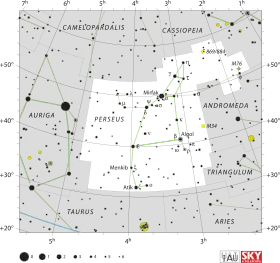48 Persei
48 Persei est une étoile Be de la constellation de Persée, approximativement la 500e étoile la plus brillante du ciel par sa magnitude apparente[3]. Elle est « bien connue pour son spectre complexe et ses variations de luminosité et de vitesse »[4]. 48 Persei est la désignation de Flamsteed que lui a donné John Flamsteed dans son catalogue, publié en 1712[5] ; elle porte également la désignation de Bayer c Persei et la désignation d'étoile variable MX Persei[2].
| Ascension droite | 04h 08m 39,684s[1] |
|---|---|
| Déclinaison | +47° 42′ 45,11″[1] |
| Constellation | Persée |
| Magnitude apparente | 4,0[1] |
Localisation dans la constellation : Persée  | |
| Type spectral | B3Ve |
|---|
Autres désignations
c Per, 48 Per (Flamsteed), MX Per, BD+47°939, HR 1273, HIP 19343, HD 25940, FK5 152, SAO 39336[2]
En tant qu'étoile Be, elle est bleue et chaude, tournant sur elle-même si rapidement qu'un disque équatorial instable de matière s'est formé autour d'elle. Sa masse a été estimée à sept fois celle du Soleil, et son âge estimé à 40 millions d'années fait qu'elle est beaucoup plus jeune que le Soleil. Dans quelques millions d'années, elle cessera probablement la fusion de l'hydrogène dans son cœur, gonflera, et brillera beaucoup plus en devenant une géante rouge[6].
Références
- Frosty Drew Observatory & Sky Theatre — 48 Persei
- (en) * c Per -- Be Star sur la base de données Simbad du Centre de données astronomiques de Strasbourg.
- « 48 Persei (HIP 19343) », Ashland Astronomy Studio (consulté le ).
- J. R. Percy et M. C. Lane, « Search for Beta Cephei stars. I - Photometric and spectroscopic studies of northern B-type stars », Astronomical Journal, vol. 82, , p. 353–359 (DOI 10.1086/112057, Bibcode 1977AJ.....82..353P).
- Francis Baily, An account of the Revd. John Flamsteed, the first astronomer-royal: compiled from his own manuscripts, and other authentic documents, never before published. To which is added his British catalogue of stars, cor. and enl., Lords Commissioners of the Admiralty, (lire en ligne), p. 425.
- (en) James B. Kaler, « 48 Per (48 Persei) », sur Stars.
Lien externe
- (en) * c Per -- Be Star sur la base de données Simbad du Centre de données astronomiques de Strasbourg.
Lectures complémentaires
- (en) G. Jackisch, « Photoelectric and Spectroscopic Observations of 48 Persei and 53 Persei », Information Bulletin on Variable Stars, vol. 40, , p. 1 (Bibcode 1963IBVS...40....1J).
- (en) S. D. Baliunas, M. A. Ciccone, E. F. Guinan et P. Miskinis, « Photoelectric Study of the Bright Be Stars γ Cas, 48 Per, ψ Per, and φ Per. », Bulletin of the American Astronomical Society, vol. 7, , p. 252 (Bibcode 1975BAAS....7Q.252B).
- (en) P. S. Goraya, « Recent changes in the spectrum of the Be star 48 Persei », Astrophysics and Space Science, vol. 109, no 2, , p. 373–380 (DOI 10.1007/BF00651283, Bibcode 1985Ap&SS.109..373G).
- (en) N. S. Tur, P. S. Goraya et U. S. Chaubey, « Continuum energy dissipation of 48 Persei », Astrophysics and Space Science, vol. 139, no 2, , p. 257–262 (DOI 10.1007/BF00644354, Bibcode 1987Ap&SS.139..257T).
- (en) Xiao-Zhen Guo, Zi-He Guo et Jin-Xin Hao, « A study of the low dispersion spectrum and photometry of the Be star 48 Per in 1989 », Acta Astronomica Sinica, vol. 32, no 4, , p. 415–420 (Bibcode 1991AcASn..32..415G).
- (en) Jinxin Hao, Huang Lin, C. Catala et B. H. Foing « Nonradial pulsations in 48 Persei: results from MUSICOS 1989 campaign » (Bibcode 1995mscs.conf...91H)
—Multi-site Continuous Spectroscopy (Pékin, 19-24 juin 1994)
— « (ibid.) », dans Multi-site Continuous Spectroscopy. Proceedings of the 4th workshop held in Beijing, China, June 19-24, 1994, , p. 91. - (en) Hubert, A. M.; Floquet, M.; Hao, J. X.; et al., « Multi-site continuous spectroscopy. V. Rapid photospheric variability in the Be star 48 Persei from the MUSICOS 1989 campaign », Astronomy & Astrophysics, vol. 324, , p. 929–940 (Bibcode 1997A&A...324..929H).
- (en) O. Delaa, Ph. Stee, A. Meilland et al., « Kinematics and geometrical study of the Be stars 48 Persei and ψ Persei with the VEGA/CHARA interferometer », Astronomy & Astrophysics, vol. 529, (DOI 10.1051/0004-6361/201015639, Bibcode 2011A&A...529A..87D).